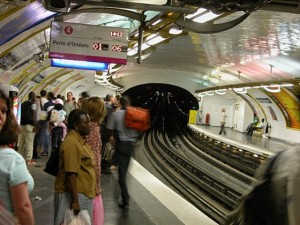 A futuristic Paris Habitat project plans to use the combined warmth generated by humans waiting in the Rambuteau Metró subway station to heat a public housing project.
A futuristic Paris Habitat project plans to use the combined warmth generated by humans waiting in the Rambuteau Metró subway station to heat a public housing project.
The project, under design engineers from Buro-Happold, a holistic environmental engineering firm with offices worldwide, will use body human heat to warm water flowing through pipes and ultimately into an under-floor heating system.
Known as radiant heat, this unique form of warming buildings from the floor up will be applied to a block of low-income apartments in the Rue Beaubourg, near the Pompidou Centre and museum, a cultural center in the heart of Paris named after former French President Georges Pompidou.
According to Dr. Patrick James of the University of Southampton (UK) School of Civil Engineering and Environment, the use of this huge resource is so intuitive that many researchers are surprised it hasn’t been employed more often on the continent.
In the Scandinavian countries of Sweden and Norway, the use of subway or underground heat is becoming quite common. While transit tunnels warm an office building in Stockholm, sanitary sewers heat the entire city of Oslo.
The only drawback to the Paris plan, says James, would be a transit strike in the winter, idling the Metró. The advantages, free heat, no carbon emissions, and the fact that the apartments are connected to the subway tunnel via an old stairwell that can accommodate the hot-water piping, are all that is needed to turn an inventive proposition into a reality, according to Paris Habitat spokesman Francois Wachnick.
Paris Habitat, the city’s largest single owner of social housing, estimates that each waiting passenger provides 100 watts in expended body human heat. This, combined with the heat from the trains, keeps Metró temperatures about 14-20 degrees Celsius (57-68 degrees Fahrenheit) in the summer and winter.
The system will use geothermal engineering principles to move heat from underground tunnels to heat exchangers, which in turn deliver their heating capacity to water pipes, the whole complementing a system of district heating already in place and cutting carbon emissions by 33 percent over a boiler system.
Expected to heat 17 apartments, the proposal is out for bid, and work is expected to begin next year. Unfortunately, the system is only cost effective as a result of the existing stairwell, Wachnick said, so extending it to other areas of the city is unlikely.
The UK is also considering using a similar system to meet its 2016 mandate of carbon-zero emission new buildings, given that heating accounts for 66 percent of the average UK home’s carbon emissions, according to James.
Related on




This is very interesting, You are an excessively professional blogger. I’ve joined your rss feed and look ahead to searching for extra of your magnificent post. Additionally, I’ve shared your website in my social networks!